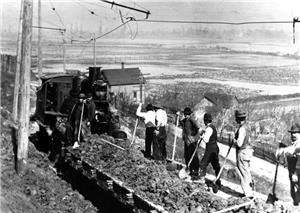On November 8, 1912, a landslide obliterates a mile of track in West Seattle on the Highland Park and Lake Burien Railway. Days of heavy rain cause a number of landslides in Western Washington. This slide occurs on a segment of the track built along a steep West Seattle slope. No one is injured, but the slide cuts off all rail service for more than a year on this new electric streetcar line. The private company that built the streetcar line does not have the financial resources to clear the track. Four months later, the line will be sold in a bankruptcy sale. In October 1913 the line will be donated at no charge to the City of Seattle, which in May 1914 will clear the mud-covered track and reinstitute service. Renamed Division C of the Seattle Municipal Railway, the streetcar line will go on to play an important role in the development of West Seattle, White Center, and Burien.
Streetcar to Lake Burien
The Highland Park and Lake Burien Railway was launched with high hopes in late 1911 by its president W. H. Murphy, George W. H. White, and a number of local investors. They believed that Lake Burien, located above the Puget Sound shoreline south of West Seattle, and "the beautiful heights south of the city limits" had considerable housing-development potential ("Lake Burien Road Sold ..."). Unfortunately, some of the investors turned out to be "very shy when it came to keeping up their stock subscriptions," so the real-estate venture was slow to take off ("Lake Burien Road Sold ..."). Yet Murphy persevered and completed the nine-mile track from West Seattle to Lake Burien in the summer of 1912. The cost: $130,000.
The first streetcar rumbled down the line on June 1, 1912. It ran from Spokane Street on the west side of the West Duwamish Waterway south to Lake Burien.
The electric rail line continued to operate intermittently for the next four months, but it was in immediate financial trouble. In early October 1912, the shareholders offered to donate the entire line as a gift to the City of Seattle, on the condition that the city maintain the line and keep it operating. The city declined. The shareholders also tried to sell the line to eastern investors, but that fell through as well.
Disaster Strikes
Then, on November 8, 1912, disaster struck. A landslide buried an entire mile of the rail line, along the steep hillsides not far from today's South Seattle College and the present Highland Park Way SW, immediately cutting off all service. After the slide, the majority of the stockholders "quit cold," and claims began to pile up in Superior Court ("Lake Burien Road Sold ..."). Murphy said he offered several times to sell to the Puget Sound Traction, Light & Power Co., which owned Seattle's streetcar franchise, but never received "even a tentative offer in return" ("Lake Burien Road Sold ..."). Murphy then resigned and washed his hands of the affair.
On March 2, 1913, The Seattle Times reported that the bankrupt line had been sold in a sheriff's sale, for the minimal sum of $12,000, "to the firm of McQuaid & Moore, the [line's original] grading contractors ... The new owners gave no intimation of what they intend to do with their purchase beyond saying that it would be taken over by persons who will operate it and develop the rich territory lying about Lake Burien" ("Lake Burien Road Sold ...").
Part of Seattle Municipal Railway
The new owners soon went back to the earlier plan. That spring, they once again offered the railway for free to the City of Seattle. The city council took months to decide whether to accept this gift. The offer was described as "unencumbered," but it did entail some costs. The city would have to repair the slide-damaged track at a cost of about $10,000 and spend another $100,000 to extend the new line across the waterway in West Seattle so it could hook up with the Seattle, Renton & Southern Railway into downtown Seattle.
However, there were compelling reasons for Seattle to consider the offer. The city had been seeking to build up its own fledgling municipal street railway system, as a counterpoint to Puget Sound Traction, Light & Power's system. In the end a majority of the city council decided not to look a gift horse in the mouth. On October 16, 1913, the council voted six to three in favor of accepting the donation of this nine-mile rail line, much to the approval of about 200 spectators, "enthusiastic residents of the territory through which the car line runs" ("City Accepts ...").
The city formally took over the line in May 1914. It rebuilt the wiped-out sections of track in West Seattle, and designated the line as Division C of the Seattle Municipal Railway. On May 30, 1914, the first car on the newly refurbished line rolled out of West Seattle, "crowded to its fullest capacity" ("Hourly Trips ..."). The line eventually accomplished its original goal of stimulating development from West Seattle all the way down through White Center and into Burien. With various connections and spur lines, people in Burien could ride 14 miles of track all the way to downtown Seattle.

